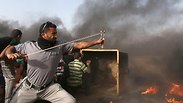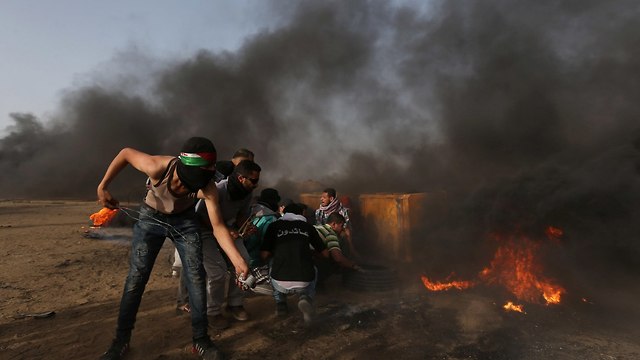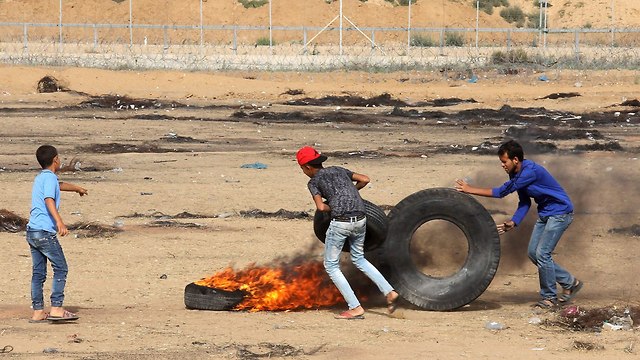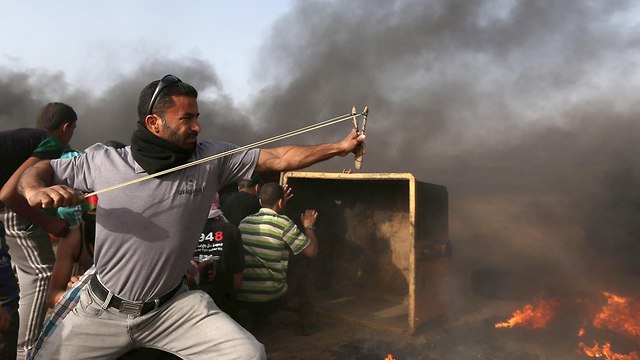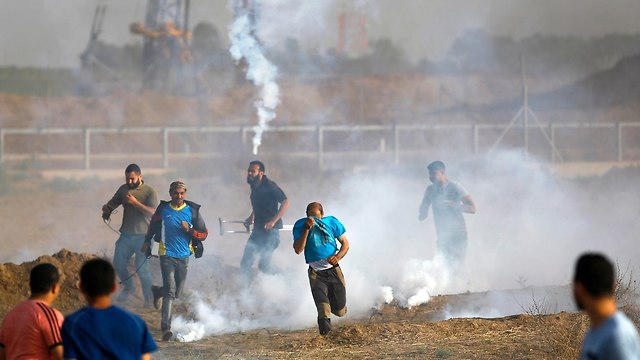An explosive device was thrown at an IDF force north of the Gaza Strip border Friday, according to the IDF Spokesperson's Unit, as "March of Return" protest sees clashes between Gazans and Israeli soldiers renew once again.
There were no casualties in the incident.
Some 1,600 Palestinian protesters have gathered in two locations along the Gaza border security fence. Most of the participants kept their distance and remained about 800 meters from the fence. Dozens of youths, however, advanced to around 300 meters distance and burned tires at one protest spot. East of Gaza City some youths came right up to the fence and tried to pull it apart.
Israeli troops fired tear gas and live rounds. Soldiers also fired at kites with flaming tails to try to bring them down before they landed in Israeli farmland and set crops alight.
Gaza health ministry officials said at least 109 protesters were hurt. Medics said at least 10 were wounded by live rounds.
Hamas chief Ismail Haniyeh and the group’s Gaza leader, Yehya Al-Sinwar, joined separate protest encampments raising cheers from the assembled crowds.
"The marches of return are not over. They may be smaller but we are continuing," said Ali, a participant who masked his face with his t-shirt at a protest east of Khan Younis in the southern Gaza Strip.
Protesters dispersed as dusk fell to prepare to break their daytime fast during the Muslim holy month of Ramadan.
Meanwhile, About 87,000 Palestinians passed through the various crossings along the Green Line from the West Bank to Jerusalem Friday morning to pray at the Temple Mount for the holy month, with some 8,000 worshipers visiting the Tomb of the Patriarchs in Hebron.
IDF forces were deployed in reinforced forces and work in cooperation with the Shin Bet, the Civil Administration, the Border Police and the Police in order to allow the Ramadan prayers alongside the defense of the settlements and the roads and maintaining order and security in the sector.
Dubbed the March of Return, the protests were launched on March 30 to demand the right of return for Palestinian refugees and their descendants to family lands or homes lost to Israel during its founding in a 1948 war.
Protests along the border reached a peak on May 14 when Gaza medical sources said at least 60 Palestinians were killed by Israeli gunfire. The violence has tapered off since but there are still sporadic flare-ups.
Since the border protests began, 113 Palestinians have been killed by Israeli fire, Gaza medical officials said.
Gaza has been controlled since 2007 by the Islamist group Hamas. Israel and Egypt, citing security concerns, maintain a de facto blockade on Gaza, which has reduced its economy to a state of collapse.
Israel has blamed Hamas for provoking the violence.
"They’re pushing civilians—women, children—into the line of fire with a view of getting casualties. We try to minimize casualties. They’re trying to incur casualties in order to put pressure on Israel, which is horrible," Israeli Prime Minister Benjamin Netanyahu told CBS News last week.
Salah al-Bardaweel, a Hamas official in Gaza, told a Palestinian television channel that the majority of those killed on May 14 were Hamas members.
